Improper organization of the chimney for the gas water heater leads to increased fire hazard, harm to life and health of people. A well-chosen and installed chimney will protect the inhabitants of the premises from the danger of burnout and fire. You should consider the structure of the chimney in detail, understand the selection criteria, the subtleties of installation.
- Chimney system
- Varieties of chimney pipes
- Steel chimney
- Double circuit sandwich
- Brick, asbestos-cement, ceramic shafts
- Corrugated aluminum foil or stainless steel leads
- Recommendations for the placement of the chimney for the gas column
- Requirements for the selection of chimney pipes
- Installing a chimney for a gas water heater
- Connection restrictions
Chimney system
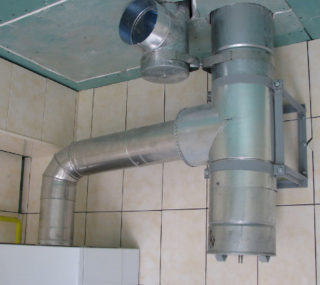
In a multi-storey building, a sealed channel connects the combustion chamber of the furnace and the ventilation pipe. In a private house, a shaft or pipe goes directly to the street. In the same way, the hood for the gas boiler is displayed when installing an autonomous heating with a gas boiler.
Chimney components:
- intake branch pipe connected to the combustion chamber;
- a pipeline for the outlet of gases of a certain length and configuration;
- rotary fittings of the outlet channel;
- container for collecting condensate (glass);
- pass-through elements;
- ventilation fungus.
Highways are made with and without insulation, depending on the needs and characteristics of the building. Warm combustion products naturally rise upward and are removed from the room. The specific gravity of hot carbon monoxide is higher than that of air. The higher the outlet point of the outlet pipe, the greater the thrust. If possible, the hood is raised as high as possible with a minimum number of turns of the gas outlet duct.
Varieties of chimney pipes

Chimneys are divided according to location and materials of manufacture. By location - into internal and external.
Indoor - indoor. Its walls are not negatively influenced by external factors - rain, negative temperatures, ultraviolet light, temperature changes. This design is more durable. The increased heat transfer is used for additional space heating.
The disadvantage of inner pipes is:
- danger of leakage of harmful gases during depressurization;
- the possibility of a fire with improper thermal insulation;
- the need for additional thermal insulation when passing through the floors;
- the chimney pipe occupies a certain place in the room and its presence sharply limits the usable area.
The construction of an internal chimney is associated with additional costs for conjugation of structures, heat protection.
External chimneys are led out through the wall of the house and go outside the building. They have many advantages:
- simplicity of construction and the possibility of integration without affecting the decoration of the house;
- price;
- ease of repair and preventive maintenance;
- safety in case of leakage of harmful gases.

Along with the advantages, there are a number of disadvantages:
- need to be insulated to reduce the formation of condensation inside the pipe;
- negative influence of the environment;
- cannot be used for additional heating of the room.
The material for the manufacture of internal and external chimney shafts is different.
Steel chimney
A steel pipe ventilation duct is the most practical. The circular cross section gives the maximum flow rate.Ideally, the pipe should be made of stainless steel. Stainless steel is resistant to acids and condensation. It does not have to be bricked. A ferrous metal pipe is lined with refractory bricks, which reduce the impact of harmful factors.
Stainless steel is sometimes enameled on the outside. The pipe looks much more aesthetically pleasing. The steel structure fits easily outside the house. No support is required.
Need a fire cut when passing through walls and partitions. It is necessary to strictly comply with the SNIP requirements for the location of the chimney structures. The condensate collection pocket is located at the bottom of the structure. The presence of one horizontal section of no more than 1 running meter is allowed. The elements are connected to each other with clamps or shaped joints. According to SNIP, the depth of pipe packing must be no less than the radius.
Double circuit sandwich
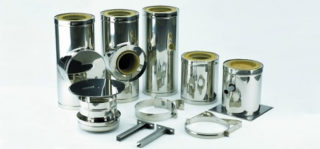
The construction of a sandwich pipe consists of 2 pipes of different diameters with a heat-resistant insulation inside. Equally suitable for indoor and outdoor use. By execution, they are divided into 2 types:
- both pipes are stainless steel;
- the inner tube is stainless, the outer one is galvanized.
The types of stainless steel used vary. Most resistant to external influences grades: AISI 430 and AISI 304. For outer casings only. For internal and external pipes: AISI 316i, AISI 321, AISI 310S. A conscientious manufacturer always indicates the steel grade. The final price of a pipe can vary greatly.
Brick, asbestos-cement, ceramic shafts

The ideal cutaway is circular. The gas velocity in this section is maximum. However, it is unprofitable and inconvenient to lay out bricks in a circular manner. Moreover, the high temperature of the gases requires laying out the channel from refractory bricks, which is not cheap. But this does not save him from fouling with soot inside. The process of laying out the chimney for the column is extremely laborious. It is necessary to correctly combine heat-resistant materials and binders. Laying out is facilitated with experience, but even knowledge of masonry technology will allow you to control the quality of the performer's work. To ensure sufficient draft, the ventilation must be raised above the ridge of the roof, depending on the location of the pipe. The closer to the edge of the house, the larger the takeaway. The maximum descent angle between the pipe head and the ridge is 10 degrees. But even with good traction, the brick collapses from the effects of acids, soot, condensation.
The flue pipe made of ceramic pipes is a complex structure. Outside, the pipe is lined with light foam concrete, and the space around the ceramics is filled with heat-insulating material. The length of the ceramic elements is 0.2-0.6 m. On one side there is a socket into which the previous element is inserted. The joints are sealed with acid resistant material. Thermal insulation should be heat-resistant, the remaining grooves in the covered blocks facilitate ventilation of the insulation and soften the thermal expansion of the ceramic pipe. The construction of the blocks for covering can be any, depending on the number and size of pipes. Manufacturing manufactures ready-made pipe-block kits with all the necessary fittings. The warranty period for these elements is up to 30 years.
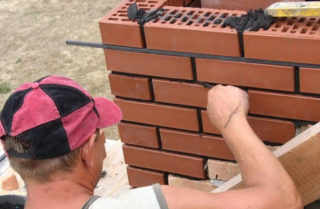
Ceramic chimneys are carried out from inside the premises. Outdoor location requires reinforcement with bricks or concrete blocks.
Advantages of ceramics:
- the inner layer of the pipe is made of a smooth heat-resistant glaze that prevents soot deposition;
- the velocity of gases in ceramics is maximum;
- the watertightness of the walls contributes to the drainage of condensate into a special pocket, so the pipes do not absorb moisture and do not collapse;
- soot is easily removed from the smooth walls of such pipes;
- ceramics are heat-resistant, even if soot ignites, nothing terrible will happen;
- the ceramic pipe does not react with acids, does not absorb moisture, is resistant to the effects of other chemical elements;
- the assembly of such a chimney does not require a special tool.
Along with the pros, there are also disadvantages:
- significant cost;
- large weight of the structure;
- obligatory foundation;
- installation accuracy.
Corrugated aluminum foil or stainless steel leads
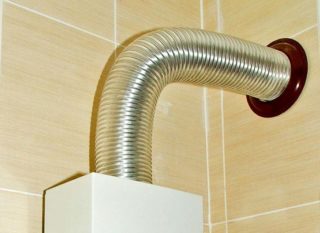
Aluminum or stainless steel sections are installed at the turns of the gas outlet route. Flexible corrugation is used to remove exhaust gases from the firebox of the column into the chimney of the apartment. They are used in turning areas, when leveling the level of pipes in areas with low temperatures. Thicker stainless steel is the best option. Thin aluminum foil tears easily and burns out quickly.
Pros of corrugation:
- ease of installation;
- simple bypass of some constructions;
- bending at different angles;
- low cost.
Significant cons:
- short service life;
- rapid contamination with combustion products.
Aluminum corrugation consists of wire and foil. The 70 cm section can stretch up to 3 m, which is very convenient. Stainless corrugation consists of metal 0.2-1 mm thick. Diameter - 110-130 mm.
Recommendations for the placement of the chimney for the gas column
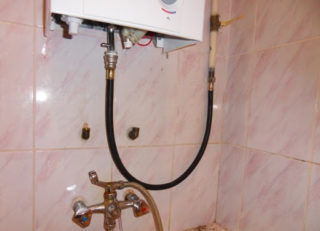
The basis for a ban on the installation of a chimney may be an insufficient area of the room. Lack of supply and exhaust is also an obstacle.
- Columns and chimneys cannot be placed in a living room or bathroom. The bathroom area is usually no more than 8 square meters. m.
- Installation in kitchens over hobs is prohibited.
- The norms allow the installation of equipment in the loggia and on the balcony.
- When operating in a kitchen, a ventilation grill should be located below.
- Flexible piping to the speaker must not exceed 2.5 m.
It is not recommended to hang the speaker on the wall adjacent to the living room. When the distance of the flexible gas supply is more than 2.5 m, the steel supply pipes are lengthened. Then the flexible sleeve is connected.
Requirements for the selection of chimney pipes
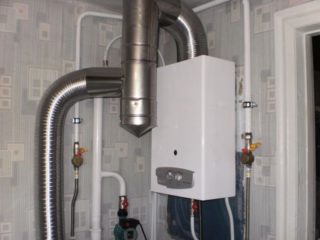
The choice of the chimney is based on the characteristics of the gas column. You need to know the smoke exhaust scheme, installation conditions, the diameter of the exhaust pipe, it is advisable to draw up a diagram indicating the dimensions and characteristics. These data will help in choosing the elements of the chimney, will allow you to get competent advice from a specialist.
According to SNIP, corrugated and other pipes for removing burnt gases from the gas column must meet the conditions:
- minimum surface roughness - SP 60.13330.2012;
- B-class tightness;
- corrosion resistance;
- have up to 3 turns;
- work in the temperature range 200-350 ° C;
- have no sagging;
- do not go through housing.
The corrugation is placed at a distance of 5 cm from a non-combustible wall or 25 cm from a combustible wall. The gap is clogged with non-flammable insulating material.
In the materials, it is allowed to use roofing or galvanized steel from 1 mm, flexible corrugated pipes, universal materials supplied with the product.
The roughness of the inner wall is allowed no more than 1 mm. Outside is not standardized. The exhaust material must be resistant to corrosion, acid compounds.
Despite the requirements of SNiPs, it is precisely corrugated joints that are popular due to their convenience. They can be placed hidden, hidden in cabinets, covering all this with removable panels.
The ideal material is stainless steel. Durability, smoothness, aesthetics - these parameters are the most successful.
Installing a chimney for a gas water heater
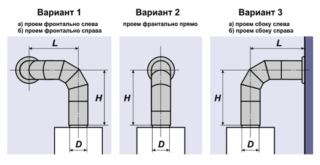
Installation of a column in the kitchen begins with measurements and preparation of the necessary materials. A corrugated transition is easiest to install.Its beginning is put on the flue pipe of the column and is fixed with a clamp. The free end is connected to the decorative ring of the flue duct or the beginning of the chimney pipe. The most important thing is that the diameters of the corrugation correspond to the gas outlet and the flue duct.
Flue ducts made of other materials are composed of straight and angled elements. They can be standard and specially adapted or made to specifications.
The assembly of the elements should be as tight as possible. If necessary, the units are sealed with a heat-resistant compound that is not afraid of acid. The entry of pipes into one another must be at least one radius. Joints are reinforced with clamps in free access areas.
The chimney should not have any deflection, contact with house structures, electrical wiring, and other communications. When the product passes through the roof and wall, grooving and heat-resistant insulation are required.
It is permissible to place no more than 3 bends, so there are few types of installation. These requirements apply to columns with an open combustion chamber. The absence of a vertical smoke exhaust channel and the use of a hole in the wall is allowed. In this case, gases are emitted by means of a forced smoke exhaust fan. Closed chamber gas heaters have their own manufacturer's recommendations.
Unauthorized installation of a column in an apartment is not recommended. Commissioning with gas supply is permitted only in the presence of a resource supplying organization. Workers check the system prior to launch, documenting launch conditions and results.
Connection restrictions
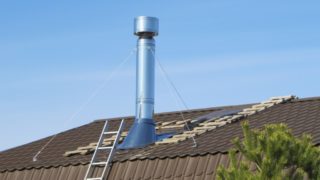
Strict compliance with the rules is important when connecting the chimney yourself. If the installation of equipment is carried out in an individual dwelling, preparatory work should be carried out even at the construction stage.
- Each device must have an individual exhaust gas outlet. As an exception, it is allowed to combine two devices at a distance of 75 cm.
- The design of the chimney ducts must comply with the requirements of building codes.
- The channels must be completely sealed. Brickwork is not 100% guaranteed.
- The traction inside the channel must be even. This is achieved with a round cross-section and no roughness on the inside.
- The chimney material is made of materials that are resistant to condensation and acids. In this case, uninterrupted operation and the absence of leaks of combustion products are guaranteed.
- The inlet and outlet diameters must match.
- There is a place for cleaning, revision and collection of condensate at the bottom of the chimney.
- According to SNIPs, gas vents are located near non-combustible partitions.
- During the installation of steel air ducts, it is assumed that adapters are used to extract the duct.
- The verticality of the pipe outside the room is allowed with a deviation of no more than 30 degrees or 1 m.
It is necessary to place the chimney on a flat roof with a height of at least 2 m. When leading to a gable roof - at least 0.5 m above the ridge.








